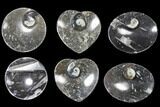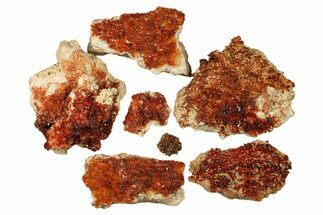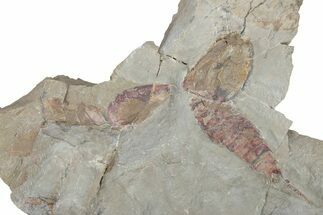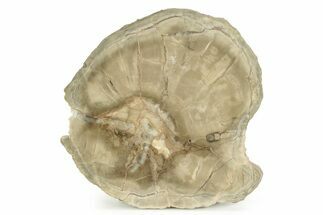This Specimen has been sold.
Lot: Stoneware With Orthoceras Fossils - 11 Pieces
These dishes come from the part of the Sahara Desert in Morocco that was a seafloor 450 million years ago. This very hard limestone was laid down over millions of years and is particularly rich in ammonites and Orthoceras. Tremendous labor was required to cut these out of solid rock, grind them to shape, and polish them to a glossy finish.
This lot contains eleven pieces in total: five 4.2" round dishes with Orthoceras, two 4.2" round dishes with Goniatites, two 4.8" oval dishes with Goniatites, and two 4.4" heart-shaped dishes with Gonitatites.
All of these dishes have either repaired cracks, small dings to the edges, or other small imperfections, hence the bargain price.
This lot contains eleven pieces in total: five 4.2" round dishes with Orthoceras, two 4.2" round dishes with Goniatites, two 4.8" oval dishes with Goniatites, and two 4.4" heart-shaped dishes with Gonitatites.
All of these dishes have either repaired cracks, small dings to the edges, or other small imperfections, hence the bargain price.
Goniatites possessed a shell divided internally into chambers filled with gas for buoyancy. An open chamber at the front of the shell provided living space for the animal. The general morphology and habit of goniatites was probably similar to that of their later relatives the ammonites: they swam freely and possessed heads with two well developed eyes and arms.
The fossils commonly known as Orthoceras are extinct "straight" cephalopods that lived during the Upper Devonian period around 370 million years ago. Like other cephalopods, they lived inside of their shells, had tentacles they could use to grab food, and used jet propulsion, squirting water to move. The rock containing them is quarried from the Atlas Mountains of Morocco and frequently polished to reveal the fossils and make decorative items with them.
While Orthoceras is the common name for these cephalopods, there are actually several different genera, including Michelinoceras and Arionoceras, found in association. However, unless you are one of the world's leading experts on fossil cephalopods, you probably won't be able to tell them apart.
While Orthoceras is the common name for these cephalopods, there are actually several different genera, including Michelinoceras and Arionoceras, found in association. However, unless you are one of the world's leading experts on fossil cephalopods, you probably won't be able to tell them apart.
SPECIES
Goniatite sp. & Orthoceras regulares
LOCATION
Erfoud Area, Morocco
SIZE
Various
CATEGORY
ITEM
#119447
We guarantee the authenticity of all of our specimens.
 Reviews
Reviews











